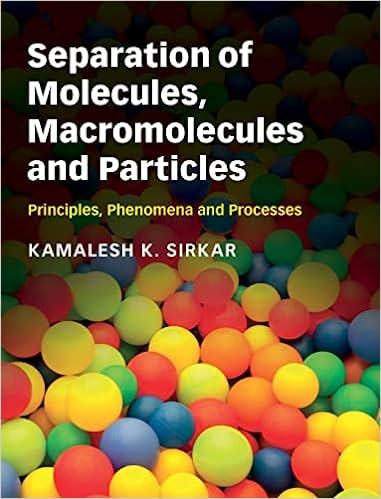Answered step by step
Verified Expert Solution
Question
1 Approved Answer
Can you please write the requirements for combustion and a conclusion for combustion report, as soon as possible please!! Combustion Table of contents Introduction combustion
Can you please write the requirements for combustion and a conclusion for combustion report, as soon as possible please!! 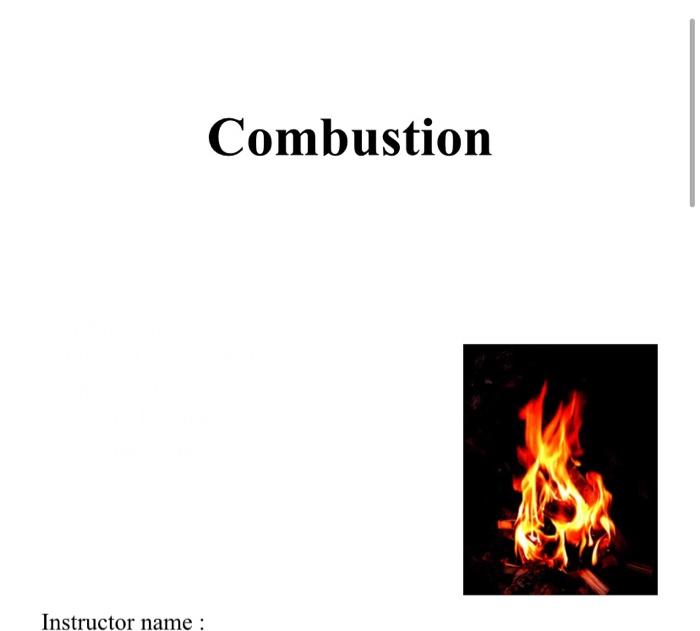
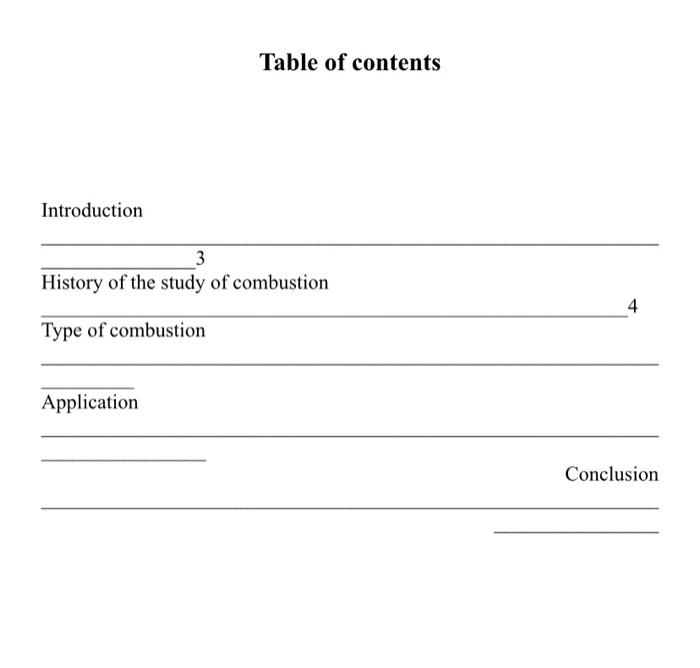
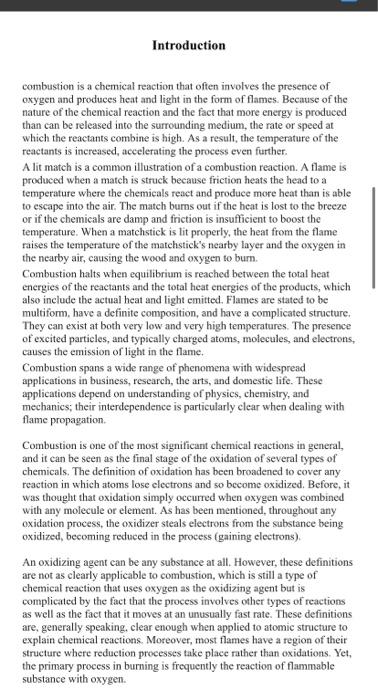
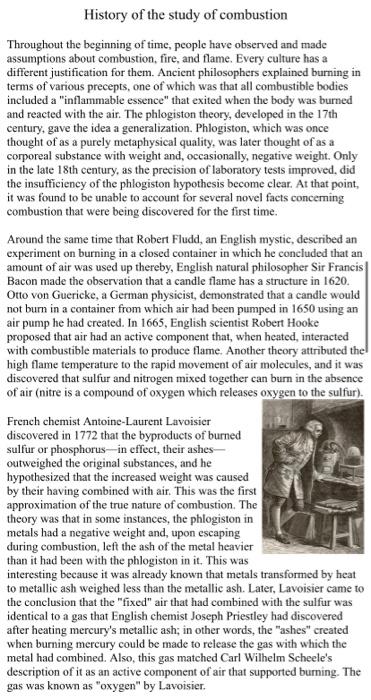
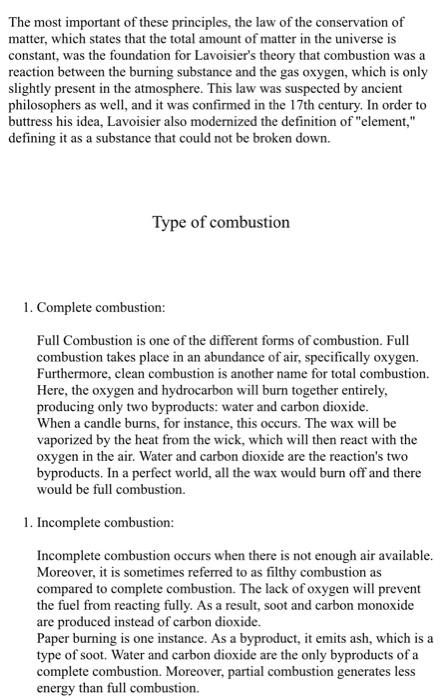
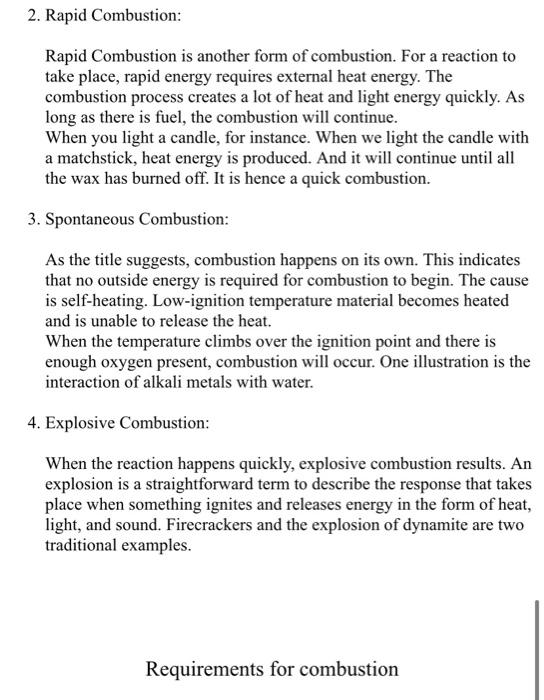
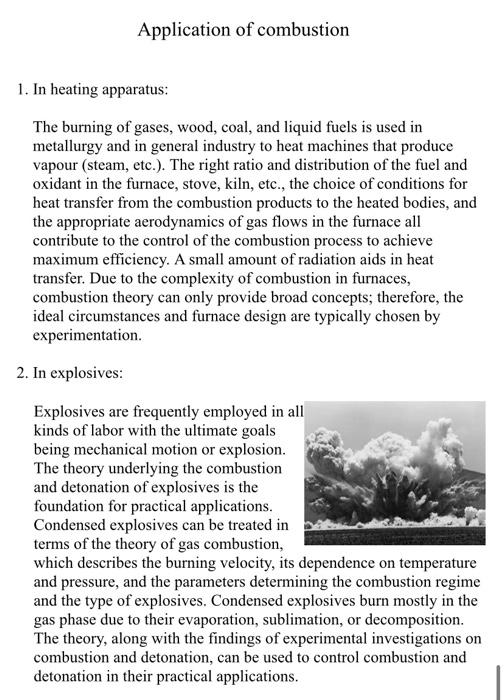
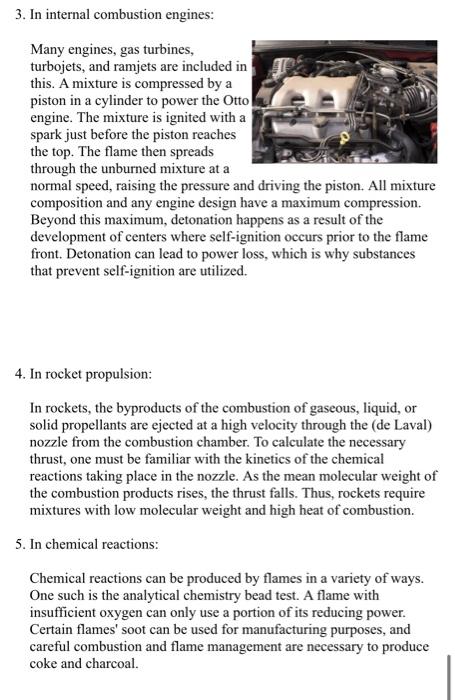
Combustion Table of contents Introduction combustion is a chemical reaction that often involves the presence of oxygen and produces heat and light in the form of flames. Because of the nature of the chemical reaction and the fact that more energy is produced than can be released into the surrounding medium, the rate or speed at which the reactants combine is high. As a result, the temperature of the reactants is increased, accelerating the process even further. A lit match is a common illustration of a combustion reaction. A flame is produced when a match is struck because friction heats the head to a temperature where the chemicals react and produce more heat than is able to escape into the air. The mateh burns out if the heat is lost to the breeze or if the chemicals are damp and friction is insufficient to boost the temperature. When a matchstick is lit properly, the heat from the flame raises the temperature of the matchstick's nearby layer and the oxygen in the nearby air, causing the wood and oxygen to burn. Combustion halts when equilibrium is reached between the total heat energies of the reactants and the total heat energies of the products, which also include the actual heat and light emitted. Flames are stated to be multiform, have a definite composition, and have a complicated structure. They can exist at both very low and very high temperatures. The presence of excited particles, and typically charged atoms, molecules, and electrons, causes the emission of light in the flame. Combustion spans a wide range of phenomena with widespread applications in business, research, the arts, and domestic life. These applications depend on understanding of physics, chemistry, and mechanics; their interdependence is particularly clear when dealing with flame propagation. Combustion is one of the most significant chemical reactions in general, and it can be seen as the final stage of the oxidation of several types of chemicals. The definition of oxidation has been broadened to cover any reaction in which atoms lose electrons and so become oxidized. Before, it was thought that oxidation simply occurred when oxygen was combined with any molecule or element. As has been mentioned, throughout any oxidation process, the oxidizer steals electrons from the substance being oxidized, becoming reduced in the process (gaining electrons). An oxidizing agent can be any substance at all. However, these definitions are not as clearly applicable to combustion, which is still a type of chemical reaction that uses oxygen as the oxidizing agent but is complicated by the fact that the process involves other types of reactions as well as the fact that it moves at an unusually fast rate. These definitions are, generally speaking. clear enough when applied to atomic structure to explain chemical reactions. Moreover, most flames have a region of their structure where reduction processes take place rather than oxidations. Yet, the primary process in burning is frequently the reaction of flammable substance with oxygen. History of the study of combustion Throughout the beginning of time, pcople have observed and made assumptions about combustion, fire, and flame. Every culture has a different justification for them. Ancient philosophers explained burning in terms of various precepts, one of which was that all combustible bodies included a "inflammable essence" that exited when the body was burned and reacted with the air. The phlogiston theory, developed in the 17th century, gave the idea a generalization. Phlogiston, which was once thought of as a purely metaphysical quality, was later thought of as a corporeal substance with weight and, occasionally, negative weight. Only in the late 18 th century, as the precision of laboratory tests improved, did the insufficiency of the phlogiston hypothesis become clear. At that point, it was found to be unable to account for several novel facts concerning combustion that were being discovered for the first time. Around the same time that Robert Fludd, an English mystic, described an experiment on burning in a closed container in which he concluded that an amount of air was used up thereby, English natural philosopher Sir Francis Bacon made the observation that a candle flame has a structure in 1620 . Otto von Guericke, a German physicist, demonstrated that a candle would not burn in a container from which air had been pumped in 1650 using an air pump he had created. In 1665, English scientist Robert Hooke proposed that air had an active component that, when heated, interacted with combustible materials to produce flame. Another theory attributed the high flame temperature to the rapid movement of air molecules, and it was discovered that sulfur and nitrogen mixed together can burn in the absence The most important of these principles, the law of the conservation of matter, which states that the total amount of matter in the universe is constant, was the foundation for Lavoisier's theory that combustion was a reaction between the burning substance and the gas oxygen, which is only slightly present in the atmosphere. This law was suspected by ancient philosophers as well, and it was confirmed in the 17 th century. In order to buttress his idea, Lavoisier also modernized the definition of "element," defining it as a substance that could not be broken down. Type of combustion 1. Complete combustion: Full Combustion is one of the different forms of combustion. Full combustion takes place in an abundance of air, specifically oxygen. Furthermore, clean combustion is another name for total combustion. Here, the oxygen and hydrocarbon will burn together entirely, producing only two byproducts: water and carbon dioxide. When a candle burns, for instance, this occurs. The wax will be vaporized by the heat from the wick, which will then react with the oxygen in the air. Water and carbon dioxide are the reaction's two byproducts. In a perfect world, all the wax would burn off and there would be full combustion. 1. Incomplete combustion: Incomplete combustion occurs when there is not enough air available. Moreover, it is sometimes referred to as filthy combustion as compared to complete combustion. The lack of oxygen will prevent the fuel from reacting fully. As a result, soot and carbon monoxide are produced instead of carbon dioxide. Paper burning is one instance. As a byproduct, it emits ash, which is a type of soot. Water and carbon dioxide are the only byproducts of a complete combustion. Moreover, partial combustion generates less energy than full combustion. 2. Rapid Combustion: Rapid Combustion is another form of combustion. For a reaction to take place, rapid energy requires external heat energy. The combustion process creates a lot of heat and light energy quickly. As long as there is fuel, the combustion will continue. When you light a candle, for instance. When we light the candle with a matchstick, heat energy is produced. And it will continue until all the wax has burned off. It is hence a quick combustion. 3. Spontaneous Combustion: As the title suggests, combustion happens on its own. This indicates that no outside energy is required for combustion to begin. The cause is self-heating. Low-ignition temperature material becomes heated and is unable to release the heat. When the temperature climbs over the ignition point and there is enough oxygen present, combustion will occur. One illustration is the interaction of alkali metals with water. 4. Explosive Combustion: When the reaction happens quickly, explosive combustion results. An explosion is a straightforward term to describe the response that takes place when something ignites and releases energy in the form of heat, light, and sound. Firecrackers and the explosion of dynamite are two traditional examples. Requirements for combustion Application of combustion 1. In heating apparatus: The burning of gases, wood, coal, and liquid fuels is used in metallurgy and in general industry to heat machines that produce vapour (steam, etc.). The right ratio and distribution of the fuel and oxidant in the furnace, stove, kiln, etc., the choice of conditions for heat transfer from the combustion products to the heated bodies, and the appropriate aerodynamics of gas flows in the furnace all contribute to the control of the combustion process to achieve maximum efficiency. A small amount of radiation aids in heat transfer. Due to the complexity of combustion in furnaces, combustion theory can only provide broad concepts; therefore, the ideal circumstances and furnace design are typically chosen by experimentation. 2. In explosives: Explosives are frequently employed in al kinds of labor with the ultimate goals being mechanical motion or explosion. The theory underlying the combustion and detonation of explosives is the foundation for practical applications. Condensed explosives can be treated in terms of the theory of gas combustion, which describes the burning velocity, its dependence on temperature and pressure, and the parameters determining the combustion regime and the type of explosives. Condensed explosives burn mostly in the gas phase due to their evaporation, sublimation, or decomposition. The theory, along with the findings of experimental investigations on combustion and detonation, can be used to control combustion and detonation in their practical applications. Many engines, gas turbines, turbojets, and ramjets are included in this. A mixture is compressed by a piston in a cylinder to power the Otto engine. The mixture is ignited with a spark just before the piston reaches the top. The flame then spreads through the unburned mixture at a normal speed, raising the pressure and driving the piston. All mixture composition and any engine design have a maximum compression. Beyond this maximum, detonation happens as a result of the development of centers where self-ignition occurs prior to the flame front. Detonation can lead to power loss, which is why substances that prevent self-ignition are utilized. 4. In rocket propulsion: In rockets, the byproducts of the combustion of gaseous, liquid, or solid propellants are ejected at a high velocity through the (de Laval) nozzle from the combustion chamber. To calculate the necessary thrust, one must be familiar with the kinetics of the chemical reactions taking place in the nozzle. As the mean molecular weight of the combustion products rises, the thrust falls. Thus, rockets require mixtures with low molecular weight and high heat of combustion. 5. In chemical reactions: Chemical reactions can be produced by flames in a variety of ways. One such is the analytical chemistry bead test. A flame with insufficient oxygen can only use a portion of its reducing power. Certain flames' soot can be used for manufacturing purposes, and careful combustion and flame management are necessary to produce coke and charcoal 







Step by Step Solution
There are 3 Steps involved in it
Step: 1

Get Instant Access to Expert-Tailored Solutions
See step-by-step solutions with expert insights and AI powered tools for academic success
Step: 2

Step: 3

Ace Your Homework with AI
Get the answers you need in no time with our AI-driven, step-by-step assistance
Get Started


